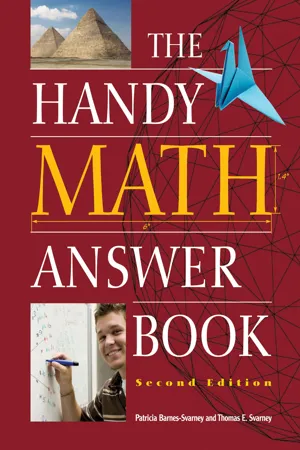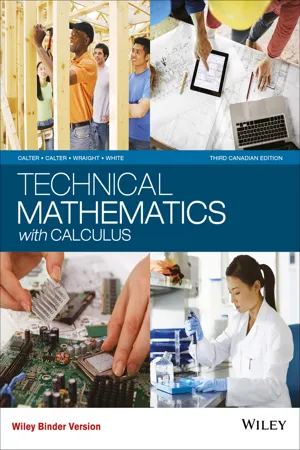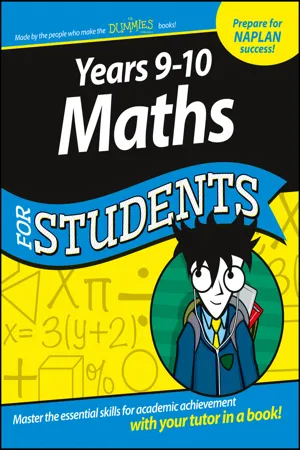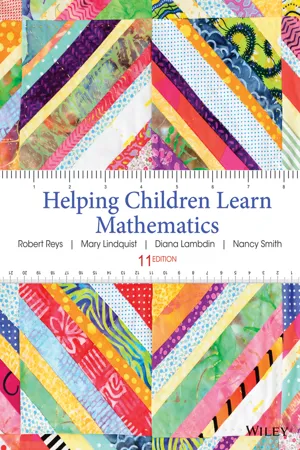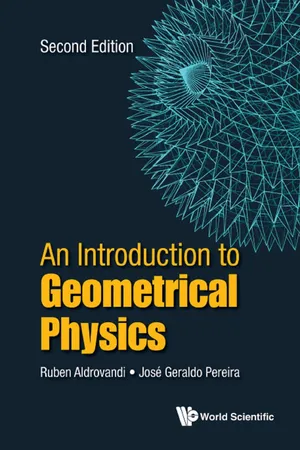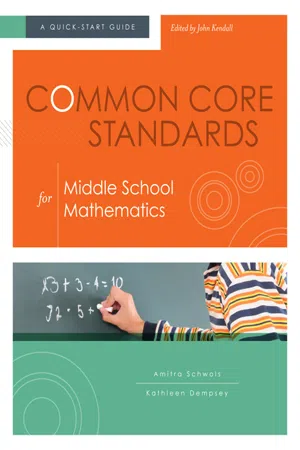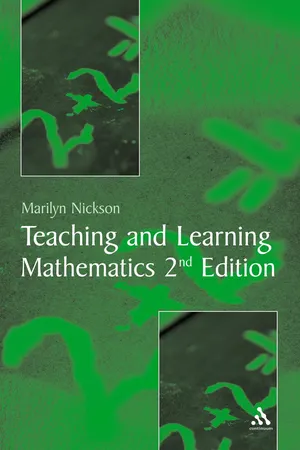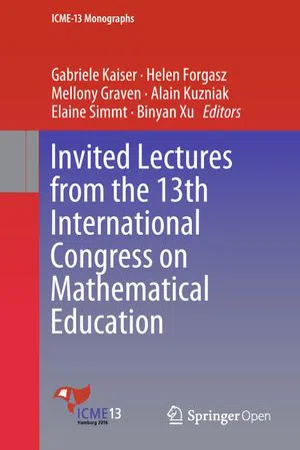Mathematics
Algebra
Algebra is a branch of mathematics that deals with symbols and the rules for manipulating those symbols. It involves solving equations, working with variables, and studying mathematical structures such as groups, rings, and fields. Algebra is essential for understanding and solving a wide range of mathematical problems in various fields, including science, engineering, and economics.
Written by Perlego with AI-assistance
Related key terms
1 of 5
12 Key excerpts on "Algebra"
- eBook - ePub
- Patricia Barnes-Svarney, Thomas E Svarney(Authors)
- 2012(Publication Date)
- Visible Ink Press(Publisher)
School Algebra is what mathematicians refer to as the Algebra we learn in middle and high school and call “arithmetic.” But for most of people, Algebra means solving polynomial equations with one or more variables; the solutions to such equations are often obtained by the operations of addition, subtraction, multiplication, division, raising to a power, and extracting a root. (For more information about all these operations, see “Math Basics.”). This also includes determining the properties of functions and graphs.But mathematicians use the word “Algebra” most often in reference to the abstract study of number systems and operations within them, such as groups, rings, and invariant theory. This is called abstract Algebra.How else is the word Algebra used?Algebra may be defined as the subjects of arithmetic and abstract Algebra, but there are other meanings. These Algebras involve vectors and matrices, the Algebra of real numbers, complex numbers, and quaternions (an operator or factor that changes one vector into another). There are also those exotic Algebras “invented” by mathematicians—usually named after the inventor—with the majority not truly understood except, perhaps, by their creators.Algebra EXPLAINED
What is an expression in mathematics? An expression in mathematics is a statement that uses either numbers, variables, or both. For example, the following are all mathematical expressions: y 4 6 - 45 × x - 74 + 5 (3 - 2)x + 4 (7 - x )In order to write an expression from a written mathematical problem, one has to interpret the text. For example, one person weighs 100 pounds and another weighs y pounds; the expression for their combined weights would be 100 + y .What are equations?In its simplest form, an equation is represented by expressions written with an equal sign in between; the two entities on either side are equal to each other. They are among the simplest mathematical problems most people deal with; in fact, most people have solved equations in their daily lives without realizing it. For example, when students first learned addition in school, they typically work on equations such as: ____ + 5 = 7, in which the blank needs to be filled. This problem could also be expressed as x + 5 = 7, a simple equation. In this case, the equation is solved when x - eBook - PDF
- Michael A. Calter, Paul A. Calter, Paul Wraight, Sarah White(Authors)
- 2016(Publication Date)
- Wiley(Publisher)
What is Algebra? Understanding the fundamental rules of Algebra is important in order to calculate results for a wide variety of situations in science and technology. Algebra is a language of mathematics that is based on generalized arithmetic using letters to represent numbers in expressions, equations, or formulas. 2 ⋅ 2 ⋅ 2 ⋅ 2 = 2 4 translates to a ⋅ a ⋅ a ⋅ a = a 4 and more generally a a a a a a n n factors ( )( )( )( ) ( ) = The material in this chapter is the foundation on which other later chapters in this book are built, so your understanding of the concepts in this chapter is important. 2 ◆◆◆ OBJECTIVES ◆◆◆◆◆◆◆◆◆◆◆◆◆◆◆◆◆◆◆◆◆◆◆◆◆◆◆◆◆◆◆◆◆◆◆◆◆◆◆◆◆◆◆◆◆◆◆◆◆◆◆◆◆◆◆◆◆◆◆ When you have completed this chapter, you should be able to: • Identify and understand all the components (literal terms, constants, and variables) that make up Algebra. • Add and subtract Algebraic expressions and identify groups using symbols like parentheses and brackets. • Complete operations using integral exponents and remove groups of symbols in Algebraic expressions. • Complete operations with Algebraic expressions using multiplication. • Complete operations with Algebraic expressions using division. Introduction to Algebra 2–1 Algebraic Expressions Mathematical Expressions A mathematical expression is a grouping of mathematical symbols, such as signs of operation, numbers, and letters. ◆◆◆ Example 1: The following are mathematical expressions: (a) x 2 - 2x + 3 (b) x 5 sin 3 ⋅ (c) + x e 5 log x 2 ◆◆◆ 41 Section 2–1 ◆ Algebraic Expressions Algebraic and Transcendental Expressions An Algebraic expression is one containing Algebraic symbols and operations (addition, subtrac- tion, multiplication, division, roots, and powers), such as in Example 1(a). A transcendental expression, such as in Examples 1(b) and (c), contains trigonometric, exponential, or logarith- mic functions. Equations None of the expressions in Example 1 contains an equal sign ( = ). - eBook - ePub
Learning and Teaching Mathematics
An International Perspective
- Peter Bryant, Terezinha Nunes(Authors)
- 2016(Publication Date)
- Psychology Press(Publisher)
The different interpretations will lead to different ways of tackling the problem and to different solutions: in the former case one finds the roots of the equation using the quadratic formula, in the latter the values of parameters p and q are sought for which the coefficients of the same powers of x in both expressions are equal (p + 2 q = 5 and 3 p - q = 1). From this first section of the chapter, one might be led to conclude that there could be as many different perspectives on Algebra as there are researchers one might choose to listen to. However, underlying all these perspectives—even a functional one—one can find a few common threads. All use Algebra at least as a notation, a tool whereby we not only represent numbers and quantities with literal symbols but also calculate with these symbols. One could stretch this definition to the extent of saying that Algebra is also a tool for calculus (in fact, historically, Algebra led to calculus). However, that would miss the point, which is that the symbols have different interpretations depending on the conceptual domain (i.e. the letters represent different objects in school Algebra than they represent in the calculus courses). In addition, some new symbols are generated and the procedures for calculating with the symbols also change in subtle ways as one moves from one mathematical sub-discipline to another. Algebra can thus be viewed as the mathematics course in which students are introduced to the principal ways in which letters are used to represent numbers and numerical relationships—in expressions of generality and as unknowns—and to the corresponding activities involved with these uses of letters—on the one hand, justifying, proving, and predicting, and, on the other hand, solving. These uses of Algebraic letters all require some translation from one representation to another; furthermore, the activities associated with these letter-uses all require some symbol manipulation - eBook - PDF
- Alberto D. Yazon(Author)
- 2019(Publication Date)
- Arcler Press(Publisher)
Algebra and Basic Math 2 CONTENTS 2.1. Fundamentals Of Algebra ................................................................. 38 2.2. Operations On Monomials and Polynomials ..................................... 40 2.3. Linear Equations In One Variable ...................................................... 46 2.4. Problems To Solve ............................................................................. 58 References ............................................................................................... 64 Fundamentals of Advanced Mathematics 38 Mathematics is a vast subject, which includes arithmetic, calculations, statistics, and various other branches. One of the significant fields that make up the great subject of mathematics is ‘Algebra.’ Algebra is the basis for all the topics that come up in the advanced form of mathematics like calculus, relations, and functions and other important topics. Hence it becomes important for the readers and learners to revise and view the basic concepts of Algebra before moving forward. 2.1. FUNDAMENTALS OF Algebra There is a very significant part of mathematics which is made up by numbers and some general rules of arithmetic and that part is commonly known as ‘Algebra.’ Algebra takes the methods and learnings of arithmetic in such a way that it becomes easy to imply the rules related with the calculation of numbers and make use of these rules to work with some symbols too other than the num-bers. The adoption of Algebra provides easy access to several other branches of mathematics, rather than an abrupt makeover into new fields, with the use of previously attained knowledge of the use of basic arithmetical operations. The way of writing quantities in some common ways instead of a particular set of arithmetic terms is widely known. - eBook - PDF
- (Author)
- 2015(Publication Date)
- For Dummies(Publisher)
Part II Algebra is Part of Everything In this part . . . ✓ Start with the basics of Algebra to lay the foundations for more advanced aspects. ✓ Get those variables under control — know how to add, subtract, multiply, divide and distribute them! ✓ Understand the workings of factorisation and finding the prime factor. ✓ Work with quadratic expressions and how they can be FOILed (and unFOILed). Chapter 6 Understanding the Basics of Algebra In This Chapter a Reminding yourself about the number basics a Working through the Algebraic symbols, and communicative and associative properties a Powering up with exponents a Understanding some of the more advanced aspects of exponents I n a nutshell, Algebra is a way of generalising arithmetic. Through the use of variables (letters representing numbers) and formulas or equations involving those variables, you solve problems. The problems may be in terms of practical applications, or they may be puzzles for the pure pleasure of the solving. Algebra uses positive and negative numbers, integers, fractions, operations, and symbols to analyse the relationships between values. In this chapter, you find some of the basics necessary to more easily find your way through the required processes and rules. Looking at the Basics: Numbers The different sets of numbers that Algebra relies on are important because what they look like and how they behave can set the scene for particular situations or help to solve particular problems. Algebra uses different sets of numbers, in different circumstances. I describe the different types of numbers here. 112 Part II: Algebra is Part of Everything Really real numbers Real numbers are just what the name implies. In contrast to imaginary numbers, they represent real values — no pretend or make‐believe. Real numbers cover the gamut and can take on any form — fractions or whole numbers, decimal numbers that can go on forever and ever without end, positives and negatives. - eBook - ePub
- Morris Kline(Author)
- 2013(Publication Date)
- Dover Publications(Publisher)
CHAPTER 5Algebra, THE HIGHER ARITHMETIC
Algebra is the intellectual instrument which has been created for rendering clear the quantitative aspect of the world .ALFRED NORTH WHITEHEAD5–1 INTRODUCTION
Mathematics is concerned with reasoning about certain special concepts, the concepts of number and the concepts of geometry. Reasoning about numbers—if one is to go beyond the simplest procedures of arithmetic—requires the mastery of two facilities, vocabulary and technique, or one might say, vocabulary and grammar. In addition, the entire language of mathematics is characterized by the extensive use of symbolism. In fact, it is the use of symbols and of reasoning in terms of symbols which is generally regarded as marking the transition from arithmetic to Algebra, though there is no sharp dividing line.The task of learning the vocabulary and techniques of Algebra may be compared with that which faces the prospective musician. He must learn to read music and he must develop the technique for playing an instrument. Since our goal in mathematics is far more the acquisition of an understanding than the attainment of professional competence, the problem of learning the vocabulary and techniques will hardly be a severe one.5–2 THE LANGUAGE OF Algebra
The nature and use of the language of Algebra are readily illustrated, although the illustration is at the moment a trivial one. Most readers have encountered parlor number games, of which the following is an especially simple example. The leader of the game says to any member of the group: Take a number; add 10; multiply by 3; subtract 30; and give me your answer. And now, says the leader, I shall tell you the number you chose originally. To the amazement of the audience he does so immediately. The secret of his method is absurdly simple. Suppose the subject chooses the number a . Then adding 10 yields a + 10. Multiplication by 3 means 3(a + 10). By the distributive axiom, this quantity is 3a + 30. Subtraction of 30 yields 3a - eBook - PDF
- Robert Reys, Mary Lindquist, Diana V. Lambdin, Nancy L. Smith(Authors)
- 2014(Publication Date)
- Wiley(Publisher)
280 Problems, Patterns, and Relations 281 3. Algebra is an art, characterized by order and internal consistency. Children who are involved in Algebraic thinking gain a better understanding of the underlying structure and properties of mathematics (Carpenter & Levi, 2000). 4. Algebra is a language that uses carefully defined terms and symbols. These terms and symbols enhance children’s ability to communicate about real-life situations and mathematics itself. 5. Algebra is a tool. In the past, many Algebra courses presented Algebra as a tool. But too often, students only learned the intricacies of the tool, without learning how to use it in any practical or meaningful way. The NCTM’s Principles and Standards (2000) do not recommend this limited approach to Algebra, nor is it the approach we will present here. Algebra is a tool, but one that should be meaningful and useful. Bringing Algebra to elementary school does not mean just adding one more topic to a crowded curriculum. It does mean using the mathematics in the curriculum to help chil- dren develop Algebraic thinking or reasoning. As Carraher and Schliemann (2010, p. 27) write “The early mathemat- ics curriculum abounds with opportunities for promoting Algebraic reasoning.” This chapter begins with a discussion of topics—problems, patterns, and relations—that will be used in the remainder of the chapter to build Algebraic thinking. After discussing the Algebraic language and symbols appropriate for ele- mentary students, we will look at ways to help children develop Algebraic thinking through representing, generalizing, and justifying. Routine problems Routine problems are often considered exercises for practicing computation, but they can also be used to build Algebraic understanding. You will find routine problems like these in every textbook: Routine Problem A: Before her birthday, Jane had 8 toy trucks. At her birthday party, she was given some more trucks. - Ruben Aldrovandi, Jose Geraldo Pereira(Authors)
- 2016(Publication Date)
- World Scientific(Publisher)
Physics deals actually with affine spaces whenever invariance under translations holds, so that the true position of the origin is irrelevant. 13.5 Algebras The word Algebra denotes, of course, one of the great chapters of Mathe-matics. But, just as the word “topology”, it has also a particular, restricted sense: it also denotes a very specific Algebraic structure. § 13.5.1 Algebra. An Algebra is a vector space A over a field F (for us, R or C ) on which is defined a binary operation (called multiplication ) m : A ⊗ A → A, ( α, β ) → m ( α, β ) = αβ such that, for all a ∈ F and α, β, γ ∈ A , the following conditions hold: (i) ( aα ) β = a ( αβ ) = α ( aβ ) ; (ii) ( α + β ) γ = αγ + βγ ; (iii) α ( β + γ ) = αβ + αγ . This defines an action of the vector space on itself. Once so defined, A is an “Algebra on F ”. When F = C , a mapping α ∈ A → α ∗ ∈ A is an involution , or adjoint operation, if it satisfies the postulates (i) α ∗∗ = α ; (ii) ( αβ ) ∗ = β ∗ α ∗ ; (iii) ( aα + bβ ) ∗ = a ∗ α ∗ + b ∗ β ∗ . In that case α ∗ is the adjoint of α . The Basic Algebraic Structures 397 § 13.5.2 Kinds of Algebras. The Algebra A is associative if further (iv) ( αβ ) γ = α ( βγ ) ∀ α, β, γ ∈ A . This property can be rendered by saying that the diagram A ⊗ A m ⊗ id m A ⊗ A ⊗ A A id ⊗ m m A ⊗ A is commutative. We say that α and β ∈ A commute when m ( α, β ) = m ( β, α ). Algebra A is commutative when m ( α, β ) = m ( β, α ) ∀ α, β ∈ A . A module can be assimilated to a commutative Algebra. Commentary 13.6 The center of an Algebra A is the subAlgebra formed by those elements commuting with all elements of A . In more detail: the centralizer (the term “commutant” is more used for von Neumann Algebras) X of a subset X of A is the set of elements of A commuting with every member of X ; the center is the centralizer of A itself. A is a unit Algebra (or unital Algebra) if it has a unit, that is, an element “ e ” such that α e = e α = α, ∀ α ∈ A.- Alan Tussy, Diane Koenig(Authors)
- 2018(Publication Date)
- Cengage Learning EMEA(Publisher)
Due to electronic rights, some third party content may be suppressed from the eBook and/or eChapter(s). Editorial review has deemed that any suppressed content does not materially affect the overall learning experience. Cengage Learning reserves the right to remove additional content at any time if subsequent rights restrictions require it. CHAPTER 8 • An Introduction to Algebra 636 OBJECTIVES 1 Use variables to state properties of addition, multiplication, and division. 2 Identify terms and coefficients of terms. 3 Translate word phrases to Algebraic expressions. 4 Evaluate Algebraic expressions. SECTION 8.1 The Language of Algebra The first seven chapters of this textbook have been an in-depth study of arithmetic. It’s now time to begin the move toward Algebra. Algebra is the language of mathematics. It can be used to solve many types of problems. In this chapter, you will learn more about thinking and writing in the language of Algebra using its most important component—a variable. THE LANGUAGE OF Algebra The word Algebra comes from the title of the book Ihm Al-jabr wa’l muqabalah, written by an Arabian mathematician around A.D. 800. THE LANGUAGE OF Algebra The word variable is based on the root word vary, which means change or changing. For example, the length and width of rectangles vary, and the unknown numbers in percent problems vary. OBJECTIVE 1 Use variables to state properties of addition, multiplication, and division. One of the major differences between arithmetic and Algebra is the use of variables. Recall that a variable is a letter (or symbol) that stands for a number. In this course, we have used variables on several occasions. For example, in Chapter 1, we let l stand for the length and w stand for the width in the formula for the area of a rectangle: A 5 lw. In Chapter 6, we let x represent the unknown number in percent problems. Many symbols used in arithmetic are also used in Algebra.- eBook - ePub
Common Core Standards for Middle School Mathematics
A Quick-Start Guide
- Amitra Schwols, Kathleen Dempsey, John Kendall(Authors)
- 2013(Publication Date)
- ASCD(Publisher)
Chapter 4Expressions and Equations
. . . . . . . . . . . . . . . . . . . .The introduction to the Common Core standards' high school Algebra domain provides some useful definitions to help differentiate the two mathematical terms expression and equation:An expression is a record of a computation with numbers, symbols that represent numbers, arithmetic operations, exponentiation, and, at more advanced levels, the operation of evaluating a function…. An equation is a statement of equality between two expressions, often viewed as a question asking for which values of the variables the expressions on either side are in fact equal. These values are the solutions to the equation. (CCSSI, 2010c, p. 62)The middle school Expressions and Equations (EE) domain provides a critical bridge between content in the Operations and Algebraic Thinking domain in earlier grades and Algebraic content students will encounter in high school. Figure 4.1 shows an overview of the Expressions and Equations domain's clusters and standards by grade level. - eBook - PDF
Teaching and Learning Mathematics
A Teacher's Guide to Recent Research and Its Application
- Marilyn Nickson(Author)
- 2004(Publication Date)
- Continuum(Publisher)
Algebra: the Transition from Arithmetic 125 Symbolization 1. There is evidence of considerable rigidity in children's interpretation of symbols when they adopt stereotypical views. This applies to literal symbols such as x and y and to '=' which, from a procedural perspective, they take to mean that a single result is expected. 2. The research suggests that for structural understanding of Algebra, children have to come to see Algebraic expressions as entities or objects. For this to happen, they must focus on the whole of the expression which is to be 'used' as an entity. This may cause confusion with the opposite situation that prevails in solving word problems and emphasis is laid on the part-whole approach and a single answer is expected. 3. Children have a stereotypical view of the way in which they expect an equation to be represented and will carry out unnecessary processes to try to get an equation into that format. 4. There is an indication of a link between children's ability to process written and spoken language (i.e. literacy) with their ability to process symbols in a mathe-matical context. While more research needs to be done in this area, it may be that making a link between their 'symbol awareness' in the context of written language and 'symbol awareness' in the context of mathematics, could lead to identifying possible weaknesses in their understanding and how they may be overcome. Proof 1. The evidence suggests that pupils at secondary school level may have a reason-able notion of what constitutes a mathematical proof. However, even where this is the case, they still value explanatory arguments rather than those of an Algebraic nature. The Algebra needed to produce a proof appears to be difficult for them when it comes to communicating and explaining the proof and, in par-ticular, in translating a verbal proof into symbols. - Helen Forgasz, Gabriele Kaiser, Mellony Graven(Authors)
- 2018(Publication Date)
- Springer Open(Publisher)
Chapter 11 The Role of Algebra in School Mathematics Liv Sissel Gr ø nmo Abstract Algebra can be viewed as a language of mathematics; playing a major role for students ’ opportunities to pursue many different types of education in a modern society. It may therefore seem obvious that Algebra should play a major role in school mathematics. However, analyses based on data from several international large-scale studies have shown that there are great differences between countries when it comes to Algebra; in some countries Algebra plays a major role, while this is not the case in other countries. These differences have been shown consistent over time and at different levels in school. This paper points out and discusses how these differences may interfere with individual students ’ rights and opportunities to pursue the education they want, and how this may interfere with the societies ’ need to recruit people to a number of professions. Keywords Equal rights to education Á Low emphasise on Algebra Daily life mathematics Á Different pro fi les in mathematics education 11.1 Introduction Algebra can be viewed as a language of mathematics. It is commonly accepted that competence in a countries language is essential for your opportunities in that country. The same may be said about Algebra. Competence in Algebra is essential for people across all types of education and professions where they use this lan-guage. To learn a country ’ s language takes time, and it matures over time by intensive training through listening and by training to use it yourself, and it is L. S. Gr ø nmo ( & ) LEA: Research Group for Large-Scale Educational Assessment, Department of Teacher Education and School Research, Faculty of Educational Sciences, University of Oslo, Oslo, Norway e-mail: [email protected] © The Author(s) 2018 G.
Index pages curate the most relevant extracts from our library of academic textbooks. They’ve been created using an in-house natural language model (NLM), each adding context and meaning to key research topics.
